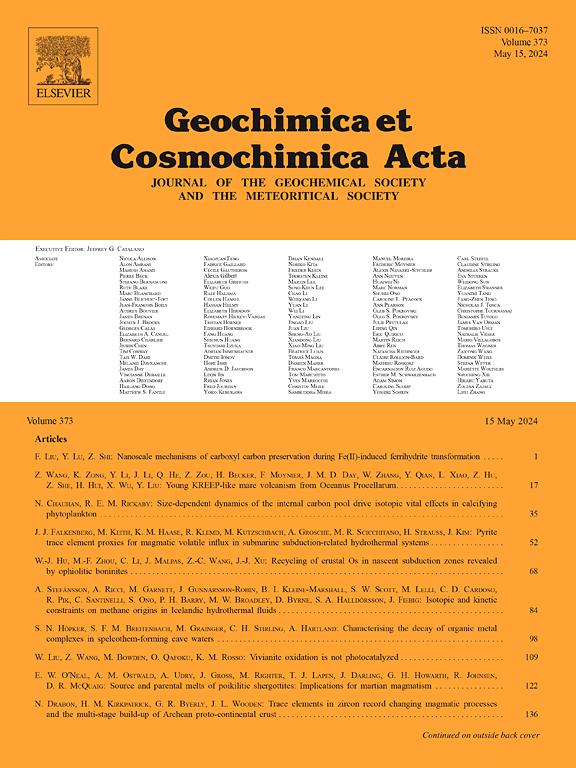Distinct patterns and drivers of total and refractory terrestrial organic carbon burial in river-dominated continental margins: From climatic control to anthropogenic perturbations
IF 5
1区 地球科学
Q1 GEOCHEMISTRY & GEOPHYSICS
引用次数: 0
Abstract
The burial of terrestrial organic carbon (OCterr) in marine sediments is a major geological CO2 sink. The largest sink for OCterr burial in present-day oceans lies in river-dominated continental margins, which are key components of the global carbon cycle. Climate change and anthropogenic forcing have disrupted the cycling of OCterr at the land–ocean interface, impacting its storage at these margins. Despite this recognition, the fate of OCterr in marine sediments and the potential feedback mechanisms of these changes remain unclear, primarily because of the lack of reliable sedimentary records from 1850 to the present that capture the substantial internal spatial and temporal heterogeneity. Here, we present a high-resolution OCterr record covering the past two centuries from a well-preserved sediment core in the mud depocenter of the East China Sea, using sedimentological, mineralogical, and geochemical techniques. By integrating our new results with literature data, we quantitatively evaluate the modern patterns and drivers of changes in OCterr burial. During the climate-controlled period (pre-1950s), despite high precipitation and sediment influx driven by the East Asian summer monsoon, the observed lower and fluctuating OCterr loadings suggest that the OCterr accumulation rate was not directly proportional to the lithogenic sediment flux. Analyses of X-radiographs and sediment composition indicate that energetic marine processes—such as tides, waves, and typhoon events that are intensified by the East Asian winter monsoon—promoted sediment resuspension, dispersion, and redeposition. These dynamic physical processes regulate hydrodynamic particle sorting, resulting in the high variability and suppression of OCterr burial during this interval. In contrast, the post-1950s era, marked by intensive human impact, saw a persistent decline in the overall OCterr burial. This trend is primarily attributed to the reduced delivery of fine mineral sediments and altered sediment sources to marine environments mainly due to large-scale dam construction. Although the preservation of sedimentary OCterr has diminished, our study provides new evidence of increased mobilization and burial of refractory OCterr in marine sediments. Using a chemical oxidation method, we quantified the proportions of refractory organic carbon (OC) and found that, on average, 60 ± 11 % of the refractory OC exported by the Yangtze River is delivered to the adjacent continental margin. Coinciding with periods of intensive human impact (post-1950s), anthropogenic disturbances, notably inputs of fossil-derived OC, have reintroduced greater quantities of unreactive OCterr into coastal oceans. This shift contributed to an increase of ∼ 20 % in the accumulation rate of refractory OCterr. The contrasting responses of the total and refractory OCterr highlight a disruption in the balance between oxidation and preservation processes within marine sediments. Such imbalances may have a substantial, yet previously unrecognized, influence on the capacity of modern continental margin sediments globally to sequester OCterr.
河流主导的大陆边缘总有机碳和难降解陆地有机碳埋藏的独特模式和驱动因素:从气候控制到人为扰动
海洋沉积物中陆相有机碳(OCterr)的埋藏是一个主要的地质CO2汇。当今海洋中最大的OCterr埋藏库位于河流主导的大陆边缘,这是全球碳循环的关键组成部分。气候变化和人为强迫破坏了陆地-海洋界面的OCterr循环,影响了其在这些边缘的储存。尽管认识到这一点,OCterr在海洋沉积物中的命运和这些变化的潜在反馈机制仍然不清楚,主要是因为缺乏从1850年到现在的可靠的沉积记录来捕捉大量的内部时空异质性。本文利用沉积学、矿物学和地球化学技术,对东海泥沉积中心一个保存完好的沉积物岩心进行了长达两个世纪的高分辨率OCterr记录。通过将我们的新结果与文献数据相结合,我们定量评估了OCterr埋葬的现代模式和变化的驱动因素。在气候控制时期(20世纪50年代前),尽管东亚夏季风驱动了大量降水和沉积物流入,但观测到的OCterr负荷较低且波动,表明OCterr积累速率与岩石沉积通量不成正比。对x射线照片和沉积物组成的分析表明,东亚冬季季风加剧的潮汐、波浪和台风事件等高能海洋过程促进了沉积物的再悬浮、分散和再沉积。这些动态物理过程调节着流体动力颗粒分选,导致OCterr埋藏在这段时间内的高变异性和抑制。相比之下,20世纪50年代后,由于人类活动的强烈影响,墓葬的总体数量持续下降。这一趋势主要是由于大规模水坝建设减少了向海洋环境输送细矿物沉积物和改变了沉积物来源。尽管沉积OCterr的保存已经减少,但我们的研究提供了新的证据,证明海洋沉积物中难熔OCterr的动员和埋藏增加了。利用化学氧化法对难降解有机碳(OC)含量进行了定量分析,结果表明,长江输出的难降解有机碳平均有60 ± 11 %输往邻近大陆边缘。与人类强烈影响的时期(20世纪50年代以后)相一致,人为干扰,特别是化石来源的OC的输入,使大量未反应的OCterr重新进入沿海海洋。这种转变导致难熔OCterr的埋藏通量增加 ~ 20 %。总OCterr和耐火OCterr的对比反应突出了海洋沉积物中氧化和保存之间平衡的破坏。这种不平衡可能对全球现代大陆边缘沉积物隔绝OCterr的能力产生巨大的、但以前未被认识到的影响。
本文章由计算机程序翻译,如有差异,请以英文原文为准。
求助全文
约1分钟内获得全文
求助全文
来源期刊

Geochimica et Cosmochimica Acta
地学-地球化学与地球物理
CiteScore
9.60
自引率
14.00%
发文量
437
审稿时长
6 months
期刊介绍:
Geochimica et Cosmochimica Acta publishes research papers in a wide range of subjects in terrestrial geochemistry, meteoritics, and planetary geochemistry. The scope of the journal includes:
1). Physical chemistry of gases, aqueous solutions, glasses, and crystalline solids
2). Igneous and metamorphic petrology
3). Chemical processes in the atmosphere, hydrosphere, biosphere, and lithosphere of the Earth
4). Organic geochemistry
5). Isotope geochemistry
6). Meteoritics and meteorite impacts
7). Lunar science; and
8). Planetary geochemistry.
 求助内容:
求助内容: 应助结果提醒方式:
应助结果提醒方式:


